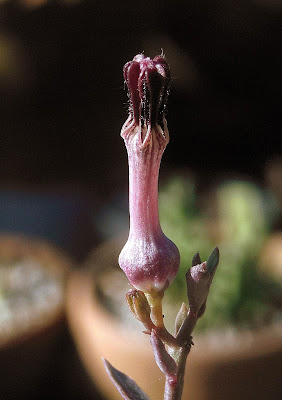The persistent Ceropegia buds
A Ceropegia africana was among the stapeliad cuttings I received last year, Nov. 21, and has grown so admiringly well that the plant rooted without any issues and quickly formed a rounded, above-ground tuber about 1.5 cm in diameter. Like most of my succulents, it was left in the open, under sun and rain, and thrived enough to eventually produce two side shoots by the end of December. By mid-February I decided to cut the branches and have these rooted, but noticed that one of the shoots showed a couple of tiny flower buds. With most other plants, any bud from a shoot that was cut for propagation purposes will deteriorate and fall off, but am curious if the water and nutrients stored in the plant's succulent leaves and stems will be enough to sustain the buds until the cutting roots and become self-sustaining. The problem was that it took an awful lot of time before the stems callused and the cut portions actually became watery that necessitated their removal, resulting in even shorter cuttings. So I placed the cuttings under even brighter light, and thus more heat. All that time, the minuscule buds were persistent enough to remain on one of the cuttings, although development has perceptibly came to a standstill. When the wounds healed up, I immediately potted the cuttings in an even mixture of S1 and pumice with grain sizes ranging from ca. 2 mm to 1 cm., to which I also added chunks of inorganic soil and 5 pieces of time release fertilizers.
By March one of the buds increased noticeably in size, and yesterday afternoon, March 12, it finally opened shop. Notice the narrow leaves from this cutting. Those leaves were substantially wider, much flatter, and more succulent prior to being cut; without a doubt, the water and nutrient reserves have been depleted, although that is immaterial now.
The entire flower is only 2 cm high, with corolla tips that appear like grasping tongs, albeit edged with silvery, motile trichomes. Flowers of this species attain heights of up to 3 cm, and the small size of this flower may only be attributed to the very limited nutrients the bud received prior to the rooting of the stem. We shall know in the flowers to come.
Ceropegia africana subsp. barklyi is similar to the nominate subspecies, but differs in having the corolla lobes about as long as the corolla tube. The corolla lobes of C. africana subsp. africana are noticeably shorter. For those not too familiar with botanical jargon, the corolla lobes are those narrow, dark purple 'petals', while the corolla tube is that pink, tubular portion of the flower, but not including the inflated base. The entire corolla structure actually corresponds to the petals seen in other flowers from other plant families, but the terminologies differ in the family Apocynaceae, where Ceropegia belongs.
By March one of the buds increased noticeably in size, and yesterday afternoon, March 12, it finally opened shop. Notice the narrow leaves from this cutting. Those leaves were substantially wider, much flatter, and more succulent prior to being cut; without a doubt, the water and nutrient reserves have been depleted, although that is immaterial now.
The entire flower is only 2 cm high, with corolla tips that appear like grasping tongs, albeit edged with silvery, motile trichomes. Flowers of this species attain heights of up to 3 cm, and the small size of this flower may only be attributed to the very limited nutrients the bud received prior to the rooting of the stem. We shall know in the flowers to come.
Ceropegia africana subsp. barklyi is similar to the nominate subspecies, but differs in having the corolla lobes about as long as the corolla tube. The corolla lobes of C. africana subsp. africana are noticeably shorter. For those not too familiar with botanical jargon, the corolla lobes are those narrow, dark purple 'petals', while the corolla tube is that pink, tubular portion of the flower, but not including the inflated base. The entire corolla structure actually corresponds to the petals seen in other flowers from other plant families, but the terminologies differ in the family Apocynaceae, where Ceropegia belongs.





Comments
Post a Comment